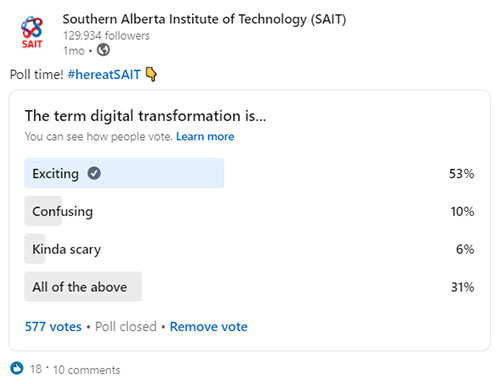Why it’s time to talk about, and understand, digital transformation

Digital transformation. Exciting or kind of scary? The term evokes a range of responses, and means different things to different people. What is certain is this: the world of work is being continually reshaped by evolving digital technologies.
To get a better understanding of perception around digital transformation, individuals following SAIT on LinkedIn were recently polled about the phrase. With 578 votes, 53% indicated the term was exciting. Slightly behind at 31%, people felt it was a combination of exciting, confusing and scary.
Based on the various opinions and reactions, especially about a phrase impacting nearly every industry, does one size, or in this case, term, really fit all?

“I think when people hear digital transformation, they think they need to invest in technology or they think it’s an 18-month process,” says Doug Junor, Corporate Training instructor from SAIT’s new School for Advanced Digital Technology. “I like the word innovation, and asking how we can build on it.”
No matter what you call it, it’s here to stay.
“It’s kind of like colour TVs versus black and white,” says Junor. “Nobody calls it a colour TV anymore. It’s just a TV. It’s the same thing with digital. Eventually, we’ll drop the word.”
Problem solving with tech
Junor’s approach and knowledge made him the perfect instructor to deliver training to the first group of Transformational Leadership for Executives, one of six course offerings in digital transformation offered through the DX Talent Hub — DX being yet another way to say digital transformation.
In late 2020, CPHR Alberta — the provincial registration body for the Chartered Professionals in Human Resources (CPHR) designation — partnered with SAIT to offer the course to senior human resources (HR) professionals. After the five-week course, leaders had the tools to implement a transformational strategy, paving the way for digital-enabled growth and innovative thinking.
“The HR professional plays an important role in leading organizations through change. To ensure competency we develop programs aligned with our competency framework to support our member's development," says Rod Miller, President and CEO of CPHR Alberta.
Stacey Norman, Talent Vice President at Ledcor and course participant, says she wanted to take Transformational Leadership for Executives to give herself a foundation of digital understanding and to help her organization be more data driven and technology focused to solve problems.
“HR is in danger of falling behind the times in terms of using digital technology to inform business decisions — in many cases, it’s our own capability holding us back,” adds Norman. “Unless we understand how technology can help to solve the challenges facing our companies, the use of technology or process isn’t going to move us forward.”
“I found the course to be very well suited for this purpose. It was at the exact right level, and provided me with great tools and practical takeaways. I would highly recommend it for other senior leaders and leadership teams.”
Bringing a digital vision to life
A group of Trimac Transportation employees recently piloted SAIT’s six-week Digital Strategy and Leadership course. Robyn Sadleir, Vice President Strategic Transportation at Trimac, saw the training as an opportunity for his team to gain understanding through a business perspective of what’s needed to bring their five-year digital vision to fruition.
The instructor customized the curriculum for Trimac specifically, choosing relevant guest speakers, video components and case studies that resonated with participants. The course helped build a shared understanding of a concept often shrouded in mystery.
“We now have a team that has an understanding of what digital transformation is,” says Sadleir.
“They are all speaking the same language and applying the learnings from the program together.”
And that, according to Amy Harvey, Client Development Manager with SAIT’s Corporate Training Solutions, is where the real education begins.
“Being able to apply the learnings back to strategies within the workplace allows a continuous learning journey to happen,” says Harvey.
“Providing digital training solutions that enhance mindset and growth is the best part of what we do.”
Don’t get left behind
Companies and leaders are faced with an important choice — adapt to the digital age or risk becoming irrelevant. It’s why we're on a mission to help organizations make digital transformation easier.
Much like digital transformation, one term or approach doesn’t always fit all. Our made-to-order corporate training solutions and tech-driven training hub will provide your team with the skills needed to succeed.
Learn from a SAIT and industry expert in digital transformation

“A lot of people believe if they’re not technical, they’re going to be left behind. I disagree. I know lots of technical people who are going to be left behind because they’re reluctant to learn new technology and ways of solving problems. Anyone willing to try new things and learn about new ways of solving problems is going to succeed.”
- Doug Junor, Instructor, School for Advanced Digital TechnologyContact us to learn how SAIT Corporate Training Solutions can help your business develop and sustain a culture of innovation — no matter where in the world — through International Corporate Training and Client Development.
Industry Driven
We prepare students for successful careers and lives.
SAIT'S
2020-2025
Strategic plan

Oki, Âba wathtech, Danit'ada, Tawnshi, Hello.
SAIT is located on the traditional territories of the Niitsitapi (Blackfoot) and the people of Treaty 7 which includes the Siksika, the Piikani, the Kainai, the Tsuut’ina and the Îyârhe Nakoda of Bearspaw, Chiniki and Goodstoney.
We are situated in an area the Blackfoot tribes traditionally called Moh’kinsstis, where the Bow River meets the Elbow River. We now call it the city of Calgary, which is also home to the Métis Nation of Alberta.